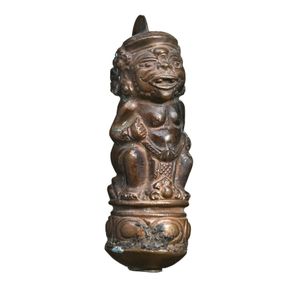18th Century French Putti Wall Console
An impressive polychrome highly decorated wall console, embellished with a central putti and laurel leaf motif, French, 18th century, 98 cm high, 94 cm wide, 48 cm deep
You must be a subscriber, and be logged in to view price and dealer details.
Subscribe Now to view actual auction price for this item
When you subscribe, you have the option of setting the currency in which to display prices to $Au, $US, $NZ or Stg.
This item has been sold, and the description, image and price are for reference purposes only.
- Putto / Putti / Amorino / Amorini - A putto (plural: putti) or amerino (plural: amerini) is a cherub or cupid frequently appearing in both mythological and religious paintings and sculpture, especially of the Renaissance and Baroque periods and later used as a decorative element in the design of furniture, ceramics, statuary etc. They are usually depicted as chubby males, or of indeterminate gender, often with wings. Their depiction may represent an association with love, heaven, peace or prosperity.
- Polychrome - Made or finished in many colours. For furniture, it is used to indicated a painted finish.
- Laurel Leaf - The use of the laurel leaf as a decorative element can be traced back to ancient Greece and Rome, where it was closely associated with victory and honour. In these cultures, the laurel was a sacred tree that was dedicated to the god Apollo and was believed to have protective and healing properties.
In ancient Greece, the laurel wreath was awarded to victors in athletic competitions, such as the Olympic Games, as a symbol of their achievement. The wreath was also associated with academic achievement, and was often worn by scholars and poets. The Greeks also used the laurel leaf as a symbol of victory in war, and it was often depicted in artwork alongside images of triumphant warriors and heroes.
The Romans continued this tradition, and the laurel wreath became a symbol of the highest military honor, the triumph, awarded to victorious generals. The wreath was also used to crown emperors and other important officials, and was often depicted in Roman art and architecture as a symbol of power and authority.
The laurel leaf is still used as a symbol of achievement, success, and excellence, and is frequently used in logos, emblems, and other branding materials. Its association with victory and honour has made it a popular choice for awards, medals, and other forms of recognition.
This item has been included into following indexes:
- wall brackets 122
Visually similar items

Bali, handle, copper modelled in the form of a Parekan figure, 10.5 cm height
Sold by
in
for
You can display prices in $Au, $US, $NZ or Stg.

A cast iron mask and bowl wall font. 86 cm high, 54 cm wide, 30 cm deep
Sold by
in
for
You can display prices in $Au, $US, $NZ or Stg.

A decorative plaster moulded bust of the goddess Kuanyin, raised on a square wooden plinth base. Height 56 cm
Sold by
in
for
You can display prices in $Au, $US, $NZ or Stg.

A Flemish carved walnut wall bracket. Engraved 'Ecco Homo' (behold the man), c irca 1460, 43 cm high, 43 cm wide, 29 cm deep
Sold by
in
for
You can display prices in $Au, $US, $NZ or Stg.
